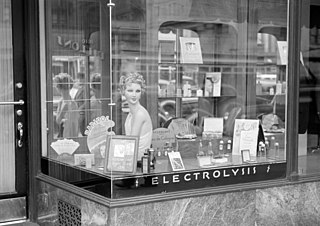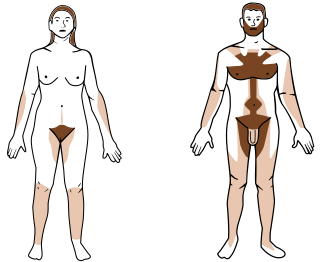Related Research Articles

Ophthalmology is a surgical subspecialty within medicine that deals with the diagnosis and treatment of eye disorders. A former term is oculism.

Electrology is the practice of electrical hair removal to permanently remove human hair from the body. Electrolysis is the actual process of removing hair using electricity.

Hair removal, also known as epilation or depilation, is the deliberate removal of body hair or head hair.

Laser hair removal is the process of hair removal by means of exposure to pulses of laser light that destroy the hair follicle. It had been performed experimentally for about twenty years before becoming commercially available in 1995 and 1996. One of the first published articles describing laser hair removal was authored by the group at Massachusetts General Hospital in 1998. Laser hair removal is widely practiced in clinics, and even in homes using devices designed and priced for consumer self-treatment. Many reviews of laser hair removal methods, safety, and efficacy have been published in the dermatology literature.

Charles David Kelman was an American ophthalmologist, surgeon, inventor, jazz musician, entertainer, and Broadway producer. Known as the father of phacoemulsification, he developed many of the medical devices, instruments, implant lenses and techniques used in cataract surgery. In the early 1960s, he began the use of cryosurgery to remove cataracts and repair retinal detachments. Cryosurgery for cataracts remained in heavy use until 1978, when phacoemulsification, a procedure Kelman also developed in 1967, became the modern standard treatment. Kelman was given the National Medal of Technology by President George H. W. Bush and recognized as the Ophthalmologist of the Century by the International Congress of Cataract and Refractive Surgery in Montreal, Canada. He was also inducted into the National Inventors Hall of Fame in Akron, Ohio, and received the 2004 Lasker Award.

Pseudofolliculitis barbae (PFB) is a type of irritant folliculitis that commonly affects people who have curly or coarse facial hair. It occurs when hair curls back into the skin after shaving, causing inflammation, redness, and bumps. This can lead to ingrown hairs, scarring, and skin discoloration. PFB can be treated with various methods, including changing shaving habits, using topical creams or ointments, and undergoing laser hair removal. Prevention measures include proper shaving techniques, using sharp razors, and avoiding too close a shave.
Marshall Miller Parks was an American ophthalmologist known to many as "the father of pediatric ophthalmology".
Charles Joseph Frédéric Carron du Villards (1801–1860) was a French ophthalmologist whose 1838 book Guide pratique pour l'étude et le traitement des maladies des yeux was an important early text in the field.
Sir William Stewart Duke-Elder was a Scottish ophthalmologist, a dominant force in his field for more than a quarter of a century.

Sir George Andreas Berry LLD, FRSE, FRCSEd was a Scottish ophthalmic surgeon who acquired a reputation as a leading authority on ophthalmology, not only in the United Kingdom but also in the United States and continental Europe. His standing in the profession was largely the result of his textbooks of ophthalmology which were widely used in his home country and abroad. His working career was spent at the Royal Infirmary of Edinburgh and when he retired from clinical practice in 1905 he became involved in medical and national politics. He was surgeon-oculist in Scotland to King George V and then to King Edward VII and was president of the Royal College of Surgeons of Edinburgh from 1910 to 1912. He was knighted in 1916. At the 1922 general election he was elected as Member of Parliament for the Combined Scottish Universities, sitting as a Scottish Unionist. He held the seat until he stood down at the 1931 general election.
Charles Conor O'Malley, BSc, MB., DOMS, KM., was an Irish eye surgeon, writer, and Chief of the Name, 1889–1982.
Stephen Updegraff, M.D., FACS is an American refractive surgeon best known for his early involvement in, and contributions to, LASIK. He is a Fellow of the American College of Surgeons, a board-certified member of the American Board of Ophthalmology, a founding member of the American College of Ophthalmic Surgeons, and a member of the International Society of Refractive Surgery, the American Academy of Ophthalmology, the American Society of Cataract and Refractive Surgery, and the Pine Ridge Eye Study Society. Updegraff currently serves as the medical director of Updegraff Vision in St. Petersburg, Florida.
John Charles White Halliday was an Australian ophthalmologist who popularised intracapsular cataract extraction in Sydney.

The Royal College of Ophthalmologists, founded in 1988, is an independent professional body and one of the Medical Royal Colleges. They set the standards and examinations for medical doctors aiming to become ophthalmologists, and provide surgical skills training, as well as services to those who have completed their training.
Noshir Minoo Shroff is an Indian ophthalmologist notable for pioneering intraocular lens implantation surgery in India. He was awarded the Padma Bhushan in 2010 by the Indian government for his services to medicine.
Paul Anton Cibis was a clinical ophthalmologist, surgeon and pioneer of modern vitreoretinal surgery. As part of Operation Paperclip Cibis came to the United States and performed research for the U.S. Air Force and studied the effects of atomic weapons testing on the eye. He was an internationally recognized expert in retinal detachment surgery and pioneered the use of liquid silicon for this procedure.
Keiki R. Mehta, an Indian ophthalmologist, medical researcher and writer, is considered by many as the father of Phacoemulsification in India. He is the Chief Surgical and Medical Director at Mehta International Eye Institute, a Mumbai-based specialty eye hospital founded by him. He is known to be the first surgeon to perform a Radial keratotomy in India and is credited with the development of the first soft eye implant in the world, and the Keiki Mehta BP Valve Glaucoma Shunt, a medical implant used in the treatment of neovascular‚ congenital and uveitic glaucoma. He is a recipient of several honours including the Grand Honors Award of the National Eye Research Foundation, Chicago and the Triple Ribbon Award of the American Society for Cataract and Refractive Surgery. The Government of India awarded him the fourth highest civilian honour of the Padma Shri, in 2008, for his contributions to Medicine.

Henry (Harry) Moss Traquair, FRSE, PRCSE was a Scottish ophthalmic surgeon who made important contributions to the science of perimetry and the use of visual field testing in the diagnosis of disease. He was President of the Royal College of Surgeons of Edinburgh in 1939/40 and President of the Ophthalmological Society of the United Kingdom.

George Ian Scott CBE, FRSE, FRCSEd was a 20th-century Scottish ophthalmic surgeon who in 1954, became the first holder of the Forbes Chair of Ophthalmology at the University of Edinburgh. He specialised in neuro-ophthalmology, studies of the visual fields and diabetic retinopathy. He was President of the Royal College of Surgeons of Edinburgh from 1964 to 1967, Surgeon-Oculist to the Queen in Scotland from 1965 and president of the Ophthalmological Society of the United Kingdom from 1970 to 1972.

Arthur Henry Havens Sinclair MD FRSE FRCSEd LLD was a 20th-century Scottish ophthalmologist. He was a pioneer of quantitative perimetry, introducing this technique of visual field testing to Britain. Sinclair also introduced the operation of intracapsular extraction of the lens for cataract into the UK. He was President of the Ophthalmological Society of the United Kingdom from 1931 to 1933 and was President of the Royal College of Surgeons of Edinburgh from 1933 to 1935. He was Surgeon-Oculist to King George VI in Scotland.
References
- 1 2 Jean-Paul Wayenborgh (2001). IBBO-International Biography and Bibliography of Ophthalmologists and Visual. p. 112.
- ↑ Wagner RF Jr, Brysk H, Tyring SK. Revisiting the Michel/Green controversy of 1879: was Carron du Villards the first to use probe/needle electrolysis for permanent hair destruction? International Journal of Dermatology 1997 Dec;36(12):947-51.
- ↑ Michel CE. Trichiasis and distichiasis; with an improved method for radical treatment. St. Louis Clinical Record, 1875 Oct; 2:145-148.